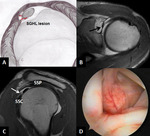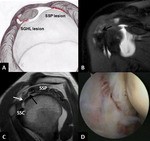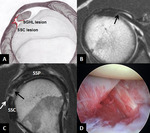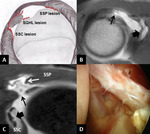Keywords:
Diagnostic procedure, Contrast agent-other, MR, Musculoskeletal system, Athletic injuries, Trauma
Authors:
G. Lanni, L. Conti, S. Mariani, V. Calvisi, A. Barile, C. Masciocchi; L'Aquila/IT
DOI:
10.1594/ecr2011/C-0613
Results
In our patients we found a narrow broad of lesions which were classified at arthro-MRI into 4 groups on the basis of Habermeyer arthroscopic classification: 3 patients had superior gleno-humeral ligament (SGHL) tear (Type I) (Fig.1),
5 patients had SGHL and supraspinatus tendon (SSP) tears (Type II) (Fig.2),
7 patients SGHL and subscapularis tendon (SSC’s) tears (Type III) (Fig.3) and 8 patients SGHL,
SSP and SSC tears (Type IV) (Fig.4).
Arthroscopic evaluation demonstrated that 1 patient had Type I,
5 patients Type II,
5 patients Type III and 10 patients Type IV lesions.
Arthro-MRI scans performed in extrarotation showed an early LHBT anteromedial subluxation in patients with Type II lesion.
A LHBT significant anteromedial subluxation was demonstrated only in patients with Type III and Type IV lesions.
At the arthroscopic dynamic test,
only 13 patients had ASI (3 with Type III and 10 with Type IV lesions).





